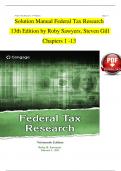Federal Tax Research, 13th Edition Page 1-1 Solution Manual Federal Tax Research 13th Edition by Roby Sawyers, Steven Gill Chapters 1 -13 Page 1 -2 SOLUTIONS MANUAL CHAPTER 1 INTRODUCTION TO TAX PRACTICE AND ETHICS DISCUSSION QUESTIONS 1-1. In the United States, the tax system is an outgrowth of the following five disciplines: law, accounting, economics, political science, and sociology. The environment for the tax system is provided by the principles of economics, sociology, and political sc ience, while the legal and accounting fields are responsible for the system‘s interpretation and application. Each of these disciplines affects this country‘s tax system in a unique way. Economists address such issues as how proposed tax legislation will affect the rate of inflation or economic growth. Measurement of the social equity of a tax and determining whether a tax system discriminates against certain taxpayers are issues that are examined by sociologists and political scientists. Finally, attorney s are responsible for the interpretation of the taxation statutes, and accountants ensure that these same statutes are applied consistently. ****8880() Page 4 1-2. The other major categories of tax practice in addition to tax research are as follows: Tax compliance Tax planning Tax litigation Page 5 1-3. Tax compliance consists of gathering pertinent information, evaluating and classifying that information, and filing any necessary tax returns. Compliance also includes other functions necessary to satisfy governmental requirements, such as representing a client during an Internal Revenue Service (IRS) audit. Federal Tax Research, 13th Edition Page 1-3 Page 5 1-4. Most of the tax compliance work is performed by commercial tax preparers, enrolled agents (EAs), attorneys, and certified public accountants (CPAs). Noncomplex individual, partnership, and corporate tax returns often are completed by commercial tax prepare rs. The preparation of more complex returns usually is performed by EAs, attorneys, and CPAs. The latter groups also provide tax planning services and represent their clients before the IRS. An EA is one who is admitted to practice before the IRS by passi ng a special IRS -administered examination, or who has worked for the IRS for five years and is issued a permit to represent clients before the IRS. CPAs and attorneys are not required to take this examination and are automatically admitted to practice befo re the IRS if they are in good standing with the appropriate professional licensing board. Page 5 and Circular 230 1-5. Tax planning is the process of arranging one‘s financial affairs to minimize any tax liability. Much of modern tax practice centers around this process, and the resulting outcome is tax avoidance. There is nothing illegal or immoral in the avoidance of taxation as long as the taxpayer remains within legal bounds. In contrast, tax evasion constitutes the illegal nonpayment of a tax and cannot be condoned. Activities of this sort clearly violate existing legal constraints and fall outside of the domain of the professional tax practitioner. Page 6 1-6. In an open tax planning situation, the transaction is not yet complete; therefore, the tax practitioner maintains some degree of control over the potential tax liability, and the transaction may be modi - fied to achieve a more favorable tax treatment. In a closed transaction however, all of the pertinent actions have been comp leted, and tax planning activities may be limited to the presentation of the situation to the government in the most legally advantageous manner possible. Page 1 -4 SOLUTIONS MANUAL Page 6 1-7. Tax litigation is the process of settling a dispute with the IRS in a court of law. Typically, a tax attorney handles tax litigation that progresses beyond the final IRS appeal. Page 6 1-8. CPAs serve is a support capacity in tax litigation. Page 6 1-9. Tax research consists of the resolution of unanswered taxation questions. The tax research process includes the following: 1. Identification of pertinent issues; 2. Specification of proper authorities; 3. Evaluation of the propriety of authorities; and, 4. Application of authorities to a specific situation. Page 6 1-10. Circular 230 is issued by the Treasury Department and applies to all who practice before the IRS. Page 7 1-11. In addition to Circular 230, CPAs must follow the AICPA‘s Code of Professional Conduct and Statements on Standards for Tax Services. CPAs must also abide by the rules of the appropriate state board(s) of accountancy. Page 7 1-12. A return preparer must obtain 18 hours of continuing education from an IRS -approved CE Provider. The hours must include a 6 credit hour Annual Federal Tax Refresher c ourse (AFTR) that covers filing season issues and tax law updates. The AFTR course must include a knowledge - based comprehension test administered at the conclusion of the course by the CE Provider.




